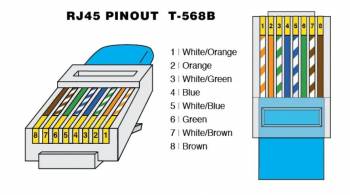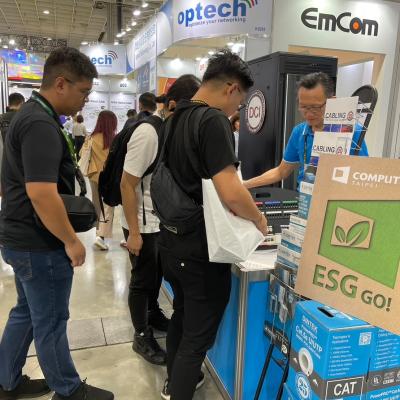A guide to cable types and connectors
Connectors in networking are just as important as the types of cables that are used to set up computer servers, transfer important data and operate the computer networks that make businesses or homes run. Your home alone can have many types of connectors and cables. You need them for home phone services, cable television, internet routers and security cameras. This guide outlines network cable types and the types of wiring connectors used for data, video and audio cables.
Types of cable
Coaxial cable
Coaxial Cable (or coax cable) is a popular choice for many applications; however, it is mainly used to transmit high-frequency signals. It is made up of a copper conductor with three layers of insulation and shielding that prevent crosstalk from motors, lighting, and other sources of EMI. Many of us are familiar with this cable because it is used for televisions.


Twisted pair cable
Twisted Pair Cable is often used for telephone communications and most modern Ethernet networks. It is a kind of wiring in which two conductors of a single circuit are twisted together. A pair of wires forms a circuit that can transmit data and the pairs are twisted together to provide protection against crosstalk, the noise generated by adjacent pairs. There are two types of twisted pair cable - unshielded twisted pair (UTP) and shielded twisted pair (STP). The commonly used UTP copper cable is now Cat.6 and Cat.6A. The STP copper cable has a foil wrapped outside on each pair of wires. The four pairs of wires then are wrapped in an overall metallic braid or foil, usually 150-ohm cable. STP cable has a better capacity of resisting noise than UTP cable, even if both of them can be used in 10GBASE-T.
Fiber optic cable
Fiber Optic Cable is a type of Ethernet cable that consists of one or more optic fibers that are used to transmit data. Fiber optic cable transmits data as pulses of light go through tiny tubes of glass. The transmission capacity of optical fiber cable is 26,000 times higher than that of twisted pair cable. Fiber optic cable can be divided into single-mode fiber (SMF) and multimode fiber (MMF). Single-mode optical fiber has a small core, and only allows one mode of light to propagate at a time. While multimode fiber cable comes with a larger core and is designed to carry multiple light rays or modes at the same time. The common single-mode fiber cable is OS2 cable, and multi-mode fiber cable is OM1, OM2, OM3, OM4, and OM5. And the transmission distance of single-mode fiber cable is up to several kilometers, while the multimode fiber is up to 550 meters over a 10G network.

Ethernet cable types
Category cables started with Cat.1 back in 1979 and the latest one is now on Cat.8. The most popular Ethernet cables now installed are Cat.6 & Cat.6A, however some old infrastructures could even still be running on Cat.3.
Cat.3
Cat.3 is four twisted pairs so a total of 8 wires and has 3 twists per foot rated up to 16MHz. Popular in the 1980s and could push up to 10Mbps ethernet. This is limited to telecom equipment and is now obsolete.
Cat.6
This standard was established back in 2002 and is rated for 250MHz and at smaller ranges (up to 164 feet); Cat.6 can handle 10Gbps data rates, which is becoming more requested in enterprise environments for both horizontal and vertical cabling.
Cat.4
The only main difference from Cat.3 is that it is rated for 20MHz; this standard quickly became obsolete.
Cat.6A
Rated for 500MHz and while it still only supports up to 10Gbps, it can handle twice the distance (332 feet) of Cat.6. Cat.6A cables come as STP or UTP.
Cat.5
Cat.5 is rated for 100MHz and speeds up to 100Mbps reliably, while it can handle more, up to 1Gbps (current standard).
Cat.7
Rated for 600MHz, it is always shielded but also uses a new connector named GG45, which is replacing the RJ45 connector that has been the industry standard up to this point.
While GG45 connectors are compatible with RJ45 sockets, these are harder to source. As a result, terminating cables with the GG45 connector is more difficult and costly. Similar to Cat.6A cables, this cable can handle data rates up to 10Gbps and distances up to 332 feet.
Cat.5e (enhanced)
This is a Cat.5 cable that is enhanced and capable of handling the disturbances on each pair that is typically caused by transmitting data across all four twisted pairs simultaneously.
Cat.8
Rated for 2000MHz and can transmit about 25 to 40Gbps data rates depending on the distance for up to 30 meters (about 100 feet). This category can use the standard RJ45 connector depending on whether it is Class I or Class II. Cat.8 cables are shielded.
Connectors
Networking cables are connected to different devices and servers via cable connectors. These connectors have different types based on their unique applications. In ethernet cable networking, RJ45 connectors are the most commonly used. And in optic fiber network cabling, three types of connectors are most commonly used. Namely, straight tip (ST) connectors, subscriber connectors (SC), Lucent connectors (LC), and Multi-fiber push-on (MPO) connectors.
RJ45 connectors
RJ45 connectors (Registered Jack 45) are the most commonly used ethernet connectors. These connectors are an upgrade on the former RJ11 connectors, which were used for connecting telephone cables. The registered jack 45 are 8p8c type connectors – eight positions, eight contacts. The conductors of the ethernet cables are inserted individually into these positions and the contacts allow the connector to pass signals to a coupler or a device. For reliable connectivity and speed, high-quality RJ45 jack contacts are plated with gold which ensures that the contacts don't corrode over extended periods. The outer body of the connectors is made from high-quality plastic which makes them almost unbreakable. The rule of thumb to identify these connectors is to count the contacts – which are eight and set them apart at approximately 1mm. The RJ45 connector is utilized to connect all categories of ethernet cables. They are fast at transmitting signals, reliable, and rugged to last extended periods.

Straight tip (ST) connectors
Subscriber connectors (SC)
The straight-tip connectors are one of the oldest optic fiber cable connectors. They support connections with both single and multi-mode fiber cables. On an ST connector, you will find a bayonet-style plug and socket. The bayonet-style plug and socket are the key to identifying an ST connector. The primary job of this connector is to connect the cables without getting the optic fiber damaged. The optic fiber is extremely fragile, therefore protecting it is one of the main jobs of the connector.
This is yet another type of optic fiber cable connector. The variety of optic fiber cable connectors is greater than ethernet cable connectors due to the obvious reason – more variety of cables. Subscriber connectors can also be used with both multi-mode and single-mode fiber cables. The structure of the SC is made from a rigid plastic that is molded into a square. On the inside, you will find a cylindrical ferrule that houses the fragile fiber. It also features push-pull locking and unlocking capability which helps secure your fiber cable nicely with your device, etc. Furthermore, the structure of the SC is standard-duplex and it is used widely for data transfer and other optic fiber applications.
Lucent (LC) connectors
Multi-fiber push-on connectors (MPO)
The Lucent connectors are an upgrade on the SC connectors. For high-speed performance over optic fiber cables, these are the go-to type of connectors. Both the structure and the built quality of the LC are phenomenal. Size-wise, they are smaller than the SC and ST, and when it comes to performance, they are more efficient at transmitting signals and more rigid and rugged for long-term use. It is used for all sorts of networking applications. Such as telecommunications, high-speed data transfer, cable television, etc.
These are the finest optic fiber cable connectors that are utilized for high-speed data transmission and other high-performance applications. They are compatible with both mono-mode and multimode connections and their prime feature is that MPO connectors can connect multiple fibers in a single ferrule. An MPO is better than multiple SC and ST connectors due to its extreme compatibility feature, that is, you can terminate multiple fibers for high-density indoor applications. It is to optic fiber cables that an RJ45 connector is to ethernet cables.
DINTEK provides quality cables and connectors
visit our product page here for our full range!







